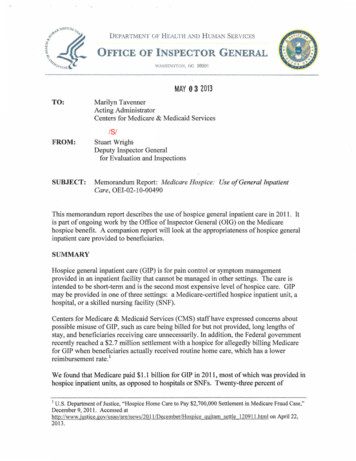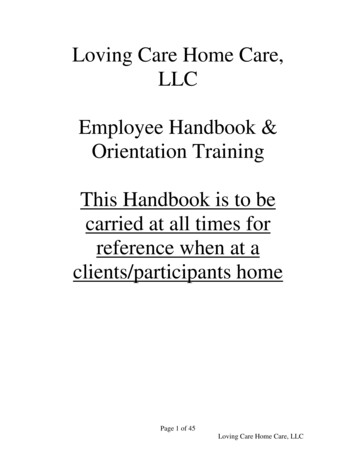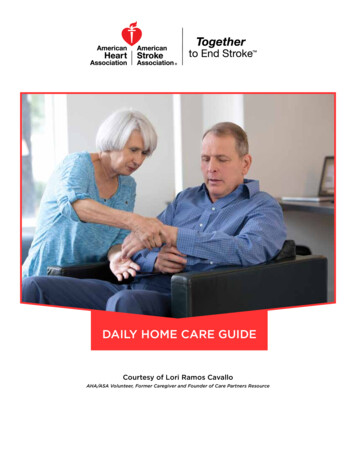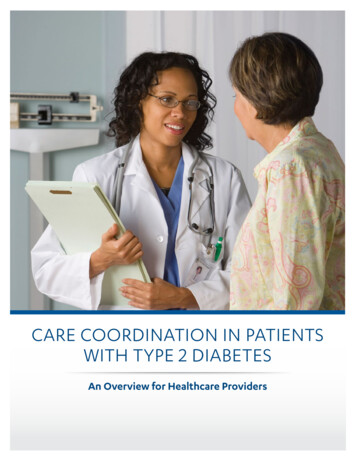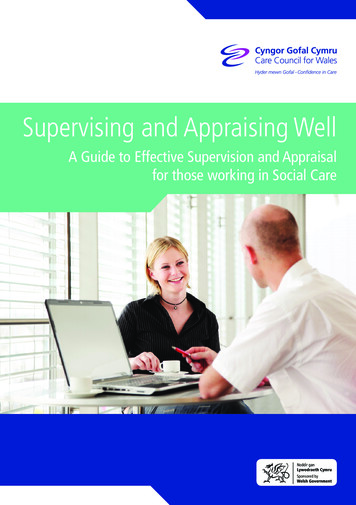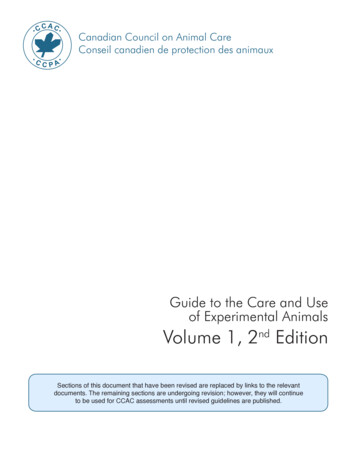
Transcription
Canadian Council on Animal CareConseil canadien de protection des animauxGuide to the Care and Useof Experimental AnimalsVolume 1, 2nd EditionSections of this document that have been revised are replaced by links to the relevantdocuments. The remaining sections are undergoing revision; however, they will continueto be used for CCAC assessments until revised guidelines are published.
EditorsDr E.D. OlfertDirectorAnimal Resources CentreUniversity of SaskatchewanSaskatoon, SaskatchewanS7N 0W0Dr B.M. CrossAsssistant DirectorAnimal Resources CentreUniversity of SaskatchewanSaskatoon, SaskatchewanS7N 0W0Mrs A.A. McWilliamInformation OfficerCanadian Council on Animal Care1000-151 Slater StreetOttawa, Ontario K1P 5H3In keeping with the CCAC policy of revising statements and guidelines as needed, users of this Guide areencouraged to forward any comments to the Secretariat.Citing certain devices or manufacturers is not to be perceived as the endorsement of the Canadian Council onAnimal Care (CCAC) of one particular product over another.Publication Date: 1993Revision Date: April 2020 Canadian Council on Animal Care, 1993ISBN: 0-919087-18-3Canadian Council on Animal Care190 O’Connor St., Suite 800Ottawa, Ontario, K2P 2R3http://www.ccac.ca
Table of ContentsTABLE OF ENTS.5CONTRIBUTORS.7I.RESPONSIBILITY FOR THE CARE AND USEOF EXPERIMENTAL ANIMALS.10AB.II.NATIONAL LEVEL. 10LOCAL LEVEL. 11LABORATORY ANIMAL FACILITIES.12A.INTRODUCTION. 12C.MECHANICAL SERVICES. 12B.D.E.F.G.H.LOCATION. 12DESIGN. 12MAJOR FUNCTIONAL DIVISIONS. 13SECURITY. 13CONSTRUCTION GUIDELINES FOR ANIMAL ROOMS . 13CAGING. 131.Shoebox Cages. 143.Suspended Cages. 142.4.III.Larger Solid Bottom Caging. 14Other Cages. 15THE ENVIRONMENT.16A.CLIMATE CONTROL. 161.Temperature. 163.Ventilation. 172.B.4.Humidity. 16Lighting. 17OTHER ENVIRONMENTAL FACTORS. 171.2.Noise. 17Chemicals. 17Guide to the Care and Use of Experimental Animals, Volume 1, 2nd Editioni
Table of Contents3.4.Bedding. 17Population Density and Space Limitations. 18C.MICROBIOLOGICAL CONTROL. 18E.REFERENCES. 18D.CHEMICAL AND RADIOISOTOPE UNITS. 18IV.FARM ANIMAL FACILITIES AND ENVIRONMENT.19V.LABORATORY ANIMAL CARE.20A.B.INTRODUCTION. 20GENERAL PRACTICES . 201.Reception. 203.Holding (Maintenance). 202.C.4.1.Food. 213.Exercise. 21Water. 21CARE OF THE FACILITY . 221.Cleaning and Sanitation. 223.Vermin Control. 222.4.VI.Identification and Records. 21CARE OF THE ANIMAL . 212.D.Conditioning/Quarantine. 20Waste Disposal. 22Holiday and Emergency Care. 22SOCIAL AND BEHAVIOURAL REQUIREMENTS OFEXPERIMENTAL ANIMALS. 23A.INTRODUCTION. 231.What is Animal Well-being or Welfare?. 233.Group Formation. 242.B.C.4.Environmental Enrichment. 24Position Statement. 25ANIMALS USED IN AGRICULTURAL RESEARCH. 26ANIMALS (LARGE) HELD IN METABOLISM CAGES. 261.Conditioning. 263.Contact with Other Animals. 272.4.5.6.7.Size of Metabolism Crates. 27Pre-, During and Post-Experiment Checks. 27Observing Changes in Behaviour. 27Duration of Confinement. 27Exceptional Circumstances. 27Guide to the Care and Use of Experimental Animals, Volume 1, 2nd Editionii
Table of ContentsD.CATS. 281.Introduction. 283.Social Peers. 292.4.5.6.7.8.E.9.Enrichment Devices (Artificial Appliances). 30Food Gathering Activities. 30Control of the Environment. 31Housing. 32Maternal Behaviour. 33Random-Source vs. Purpose-bred Animals. 33DOGS. 341.Introduction. 343.Criteria for Assessing Well-being. 352.4.5.6.7.F.Behavioural Enrichment. 29Breed Differences. 34Housing. 36Socialization to People. 37Enrichment Devices (Artificial Appliances). 38Exercise. 39NONHUMAN PRIMATES . 401.Introduction. 403.Distinctive Characteristics. 422.4.5.6.G.7.Ways of Promoting Social and Behavioural Well-being. 45Disposition. 49Summary. 501.Introduction. 503.Enrichment Devices (Artificial Appliances). 524.5.I.Assessing Social and Behavioural Well-being. 43RODENTS AND RABBITS . 502.H.Interpretation of the Behavioural and Morphological Postures. 416.Behavioural Enrichment and Social Peers. 51Caging and Bedding. 53Food Gathering. 54Control of the Environment. 54WILDLIFE HELD IN THE LABORATORY. 55REFERENCES. 56VII. SPECIAL PRACTICES. 82A.ANIMAL ACQUISITION. 821.Procurement. 823.Breeding. 822.4.Transportation. 82Breeding Transgenic Animals. 82Guide to the Care and Use of Experimental Animals, Volume 1, 2nd Editioniii
Table of Contents5.B.6.Identification of the Sexes. 83RESTRAINT AND MANIPULATIONS . 831.Physical Restraint. 833.Bleeding. 842.C.Animal Models with Special Needs. 834.Implantation, Cannulation and Sampling. 84Motivation Procedures. 85REFERENCES. 85VIII. OCCUPATIONAL HEALTH AND SAFETY.92A.REGULATORY REQUIREMENTS. 92C.ZOONOSES. 93B.D.E.F.G.H.IX.PROCEDURES FOR WORKING WITH NONHUMAN PRIMATES. 94ALLERGIES. 96PHYSICAL INJURIES AND CHEMICAL HAZARDS. 97RADIATION AND ULTRAVIOLET LIGHT. 97REFERENCES. 98STANDARDS FOR EXPERIMENTAL ANIMAL SURGERY.101A.INTRODUCTION. 101C.PRE-OPERATIVE PLANNING AND ANIMAL PREPARATION. 102B.D.E.F.X.BIOLOGICAL HAZARDS. 93FACILITIES FOR SURVIVAL SURGERY. 101SURGICAL PROCEDURES AND INTRA-OPERATIVE NURSING CARE. 103POST-OPERATIVE RECOVERY AND SUPPORT. 105REFERENCES. 107CONTROL OF ANIMAL PAIN IN RESEARCH, TEACHING AND TESTING. 109A.INTRODUCTION. 109C.GUIDELINES.111B.D.E.F.WHAT IS ANIMAL PAIN?. 109THE ROLE OF THE VETERINARIAN IN REDUCING PAIN. 112SIGNS OF PAIN AND DISTRESS. 112ANALGESIC AGENTS. 1181.Opioid Agonists. 1183.Opioid Antagonists. 1202.4.5.G.H.6.Opioid Agonist/Antagonists. 119Non-steroidal Anti-inflammatory Drugs (NSAIDS). 120Analgesia provided by Local Anesthetics. 121Neuroleptanalgesics. 121AREAS FOR FUTURE STUDY. 121REFERENCES. 123Guide to the Care and Use of Experimental Animals, Volume 1, 2nd Editioniv
Table of ContentsXI.ANESTHESIA.129A.MANAGEMENT OF ANESTHESIA. 1291.General. 1293.Fasting. 1302.B.C.4.Anticholinergics. 130TRANQUILLIZERS AND SEDATIVES. 130GENERAL ANESTHETICS . 1311.Dissociative Anesthetics. 1313.Chloralose. 1332.4.5.6.7.D.Handling the Patient. 1298.Barbiturates. 132Urethane (Urethan, Ethyl Carbamate). 133Saffan. 133Tribomoethanol (Avertin). 133Non-specific Injectable Anesthetic Antagonists. 134Inhalant Anesthetics. 134MUSCLE RELAXANTS. 1361.2.Glyceryl Guiacolate. 136Neuromuscular Blocking Agents. 136E.LOCAL AND REGIONAL ANESTHETICS. 136G.SPECIES CONSIDERATIONS. 137F.H.ANIMAL HYPNOSIS (Tonic Immobility). 137REFERENCES. 141XII. EUTHANASIA.146F.SPECIFIC SPECIES. 146H.EFFECT ON OBSERVERS. 146G.I.TISSUE EFFECTS OF EUTHANASIA METHODS. 146EUTHANASIA STATEMENTS–OTHER AGENCIES. 147XIII. THE USE OF ANIMALS IN PSYCHOLOGY.148A.THE SCIENTIST. 152C.INSTRUCTION. 155B.D.RESEARCH. 153REFERENCES. 157XIV. GUIDELINES ON THE USE OF ANIMALS INNEUROBIOLOGICAL RESEARCH.159A.INTRODUCTION. 159C.FACTORS THAT RELATE TO THE CONDUCT OF EXPERIMENTS. 160B.FACTORS THAT RELATE TO THE DESIGN OF EXPERIMENTS. 159Guide to the Care and Use of Experimental Animals, Volume 1, 2nd Editionv
Table of ContentsAPPENDICESAppendix IHousing and Environment. 162Appendix IIIPhysiological and Nutritional Parameters. 166Appendix IIAppendix IVAppendix VAppendix VIAppendix VIIAppendix VIIIAppendix IXAppendix XAppendix XIAppendix XIIAppendix XIIIAppendix XIVAppendix XVAppendix XVIBreeding and Reproduction Data. 164Hematology. 168Clinical Biochemistry Reference Values. 170Serum Electrolyte Reference Values. 172Zoonoses: Experimental Animals to Man. 174Common Bleeding Sites. 178Tranquilizer, Sedative and Anticholinergic Drug Dosages. 181Analgesic Drug Dosages. 182Injectable Anesthetic Agents: Dosage. 184Anesthetic and Sedative Drug Dosage: Amphibians and Reptiles. 185Anesthetic and Sedative Drug Dosage: Fishes. 187Methods of Euthanasia by Species. 188CCAC Position Statements. 189Journals Held by CCAC. 192Appendix XVII Glossary. 193Guide to the Care and Use of Experimental Animals, Volume 1, 2nd Editionvi
DedicationDEDICATIONThe Canadian Council on Animal Care dedicates this 2nd Edition of Volume 1 of its Guide to the Care and Useof Experimental Animals to CCAC’s founder and Executive Director until his retirement in 1992, Dr. HarryC. Rowsell. His vision and devotion to the cause of experimental animal welfare have set an example whichmany seek to emulate, but few achieve.Guide to the Care and Use of Experimental Animals, Volume 1, 2nd Edition1
PrefaceGuide to the Care and Useof Experimental AnimalsVolume 1, 2nd EditionPREFACEIn 1961, the Committee on Animal Care of the Canadian Federation of Biological Societies (CFBS) prepareda one-page placard outlining “Guiding Principles for the Care of Experimental Animals”. These principleswere quickly approved by most national scientific associations and, despite their brevity, addressed essentially the same basic principles of animal care embodied in this 2nd Edition of Volume 1 of the CanadianCouncil on Animal Care (CCAC) Guide to the Care and Use of Experimental Animals.The hundreds of pages of information contained in the current two volumes of the Guide represent steps inthe evolution of efforts by the CCAC to provide the means by which the use of animals in research, teachingand testing in Canada can be performed in accord with basic principles of humane treatment.The CCAC is deeply indebted to the many veterinarians, animal care employees, humane society members,administrators, scientists, and others who have willingly contributed time and expertise to its programs andprojects. This edition of Volume 1 of the Guide is only one example of the many CCAC directed activitiesthat owe their existence and success to the tremendous generosity and good will of these Canadians. Theirbroad participation in animal welfare is one of the most important, and least-recognized, merits of the nonlegislated, participatory, peer review system employed in Canada.Donald P.J. Boisvert, MD, PhDExecutive DirectorCanadian Council on Animal CareApril 1993Guide to the Care and Use of Experimental Animals, Volume 1, 2nd Edition2
ForwardFORWARDSince its inception in 1968, the Canadian Council on Animal Care (CCAC) has brought about enhancedanimal care and use through education, voluntary compliance, and codes of ethics. The Council’s uniqueflexibility allows it to readily respond to the concerns of both the scientific community and the generalpublic, as exemplified by numerous amendments to CCAC’s “living documents,” such as its Ethics of AnimalInvestigation, which appear elsewhere in this Guide.In line with increasing concerns for enrichment of the animal’s environment (see Social and BehaviouralRequirements of Experimental Animals), in addition to optimal physical standards, CCAC is placing increased emphasis on performance standards: it is of primary importance that the animal is comfortable andwell-adjusted.Local institutional Animal Care Committees (ACC) or Animal Research Ethics Boards (AREB) were introduced by CCAC in 1968, and are now embodied in American legislation. These committees serve as the“conscience” of the institution in order to ensure ethical concerns
The Canadian Council on Animal Care dedicates this 2 nd Edition of Volume 1 of its Guide to the Care and Use of Experimental Animals to CCAC's founder and Executive Director until his retirement in 1992, Dr. Harry C. Rowsell. His vision and devotion to the cause of experimental animal welfare have set an example which






